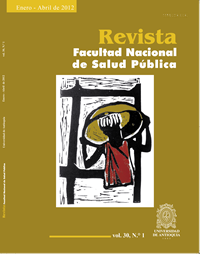Cancer: second cause of death among the elderly in Medellín, 2002-2006
DOI:
https://doi.org/10.17533/udea.rfnsp.9423Keywords:
elderly, lung neoplasms, stomach neoplasms, prostatic neoplasms, mortalityAbstract
Objective: to describe the behavior of lung, stomach, and prostate cancer mortality among the elderly in the city of Medellin from 2002 to 2006. Methodology: a descriptive study with a secondary information source. The study was conducted based on the analysis of 2809 records of deaths from lung, stomach, and prostate cancer in people over 65 years. The analysis was univariate and bivariate. Additionally, it was accompanied by statistical tests and had a reliability of 95 %. The average and specific mortality rates were calculated per ten thousand elderly individuals. Results: the risk of dying from lung cancer was at its highest value in 2003, with a rate of 20.27; for stomach cancer, the greatest risk was observed in 2002, with 11.88; finally, 2006 was the year with the highest risk for prostate cancer, with 9.35 per ten thousand inhabitants. For the three types of cancer, the average mortality rate over time was 37.1. Thus, cancer is the second leading cause of death after acute myocardial infarction. Discussion: lung, stomach, and prostate cancer pose a risk to the elderly. Moreover, the risk increases as the individuals age. This study contributes to the state of the art of the research on causes of death among the elderly.
Downloads
References
(1). Organización Mundial de la Salud. Centro de prensa: Cáncer [in-ternet]. Ginebra: oms; 2008 [acceso 4 de agosto de 2010]. Disponible en: http://www.who.int/mediacentre/factsheets/fs297/es/index.html
(2). González M, González J, Feliu J. Cáncer en el Anciano. Barcelona: Masson SA; 2001.
(3). Organización Panamericana de la Salud. Salud de las personas de edad. Envejecimiento y Salud: un cambio de paradigma. Rev. Panam. Salud Pública. 2000; 7(1): 60-67. DOI: https://doi.org/10.1590/S1020-49892000000100021
(4). Soriano JL, Carrillo G, Arrebola JA, Martín A. El cáncer en la tercera edad. Revista Cubana de Oncología. 1995; 11(1): 64-70.
(5). Jemal A, Bray F, Ferlay J, Ward E, Forman D. Estadísticas Globales de Cáncer [libro en internet]. A Cancer Journal for Clinicians; 2011 [acceso 2 de octubre de 2011]. Disponible en: http://online-library.wiley.com/doi/10.3322/caac.20107/full
(6). Organización Mundial de la Salud. Cáncer. Nota descriptiva 297 de 2012. Ginebra: oms; 2012.
(7). Núñez HN, Peña HA, Montiel A, Villalva O, Pazos J, Días G. Cáncer en el estomago [internet]. Chilpancingo de los bravo: Universidad Autónoma de Guerrero; 2011 [acceso 4 de Mayo de 2011]. Disponible en: http://www.slideshare.net/hober184/cncer-de-estmago-7141639
(8). Departamento Administrativo Nacional de Estadísticas. Registros de defunciones y proyecciones poblacionales [Internet]. Bogotá D.C: dane; 2011[acceso 3 de febrero de 2011]. Disponible en: http://www.dane.gov.co
(9). Mirra AP. Registros de cáncer en América Latina. Rev Bras Cancerología. 1997: 43 (1).
(10). Anónimo. Epidemiologia del cáncer de pulmón en España y en el mundo occidental. [Internet]. [acceso 21 de Marzo de 2011]. Disponible en: http://www.cancerpulmon.es/mas_informacion_5.html
(11). Lence JJ, Camacho R. Cáncer y transición demográfica en América Latina y el Caribe. Rev Cubana Salud Pública. 2006; 32(3).
(12). Piñol F, Paniagua M. Cáncer gástrico y factores de riesgo. Rev Cubana de Oncol. 1998; 14(3): 171-179.
(13). Organización Panamericana de la Salud. El cáncer en América Latina y el Caribe [internet]. Washington D.C: ops; 2008 [acceso 20 de Marzo de 2011]. http://www.paho.org/spanish/ad/dpc/nc/pcc-fact-sheet-LAC.pdf
(14). Benavente A. Epidemiologia del cáncer [Internet]. 2008 Jul: 19 [acceso 3 de Septiembre de 2011]. Disponible en: http://www.slideshare.net/guested4b08/epidemiologa-del-cncer-dra-ana-be-navente
(15). Agencia Internacional de Investigación sobre el Cáncer (iarc). globocan. 2008. Lyon: iarc; 2012.
Downloads
Published
How to Cite
License
Copyright (c) 2021 Luz M. Bustamante A., Sara J. Marín O., Doris Cardona A.

This work is licensed under a Creative Commons Attribution-NonCommercial-ShareAlike 4.0 International License.
The contents of the articles are the responsibility of the authors
The editorial committee has editorial independence from the National School of Public Health "Héctor Abad Gómez" of the University of Antioquia.
The editorial committee is not responsible for aspects related to copying, plagiarism or fraud that may appear in the articles published in it.
When you are going to reproduce and disclose photographs or personal data in printed or digital format, informed consent is required. Therefore, this requirement is required of the author at the time of receipt of the manuscript.
Authors are responsible for obtaining the necessary permissions to reproduce any material protected by reproduction rights.
The authors preserve the moral rights and assign the economic rights that will correspond to the University of Antioquia, to publish it, distribute electronic copies, include them in indexing services, directories or national and international databases in Open Access, under the Creative Commons Attribution license -Not Commercial-Share Equal 4.0 International Commercial (CC BY-NC-SA) which allows others to distribute, remix, retouch, and create from the work in a non-commercial way, as long as the respective credit and license are granted. new creations under the same conditions.
The authors will sign the declaration of transfer of economic rights to the University of Antioquia, after the acceptance of the manuscript.
The editorial committee reserves the right to reject the articles whose authors do not offer satisfactory explanations about the contribution of each author, to meet the criteria of authorship in the submission letter. All authors must meet the four criteria of authorship according to ICMJE: "a) .- That there is a substantial contribution to the conception or design of the article or to the acquisition, analysis or interpretation of the data. b) That they have participated in the design of the research work or in the critical review of its intellectual content. c) .- That has been intervened in the approval of the final version that will be published.d). That they have the capacity to respond to all aspects of the article in order to ensure that issues related to the accuracy or integrity of any part of the work are adequately investigated and resolved. "












 --
--  --
--
